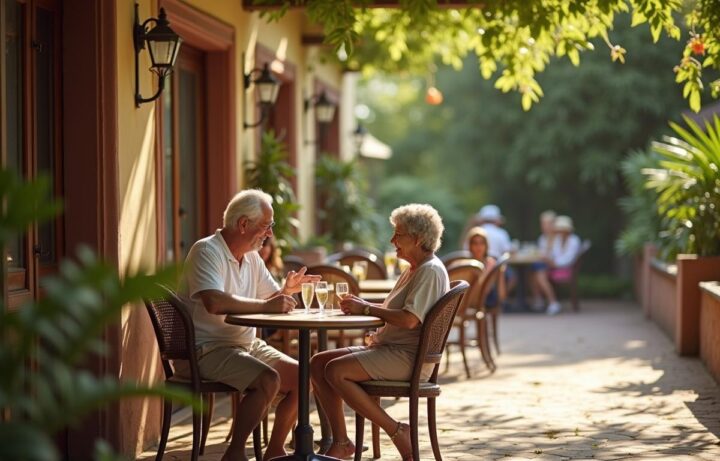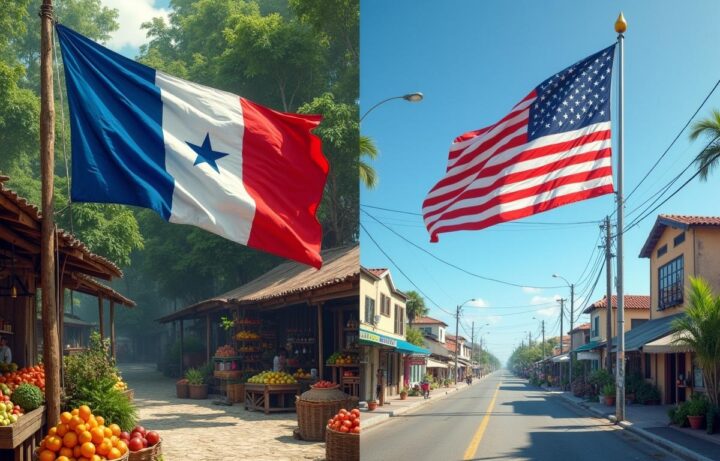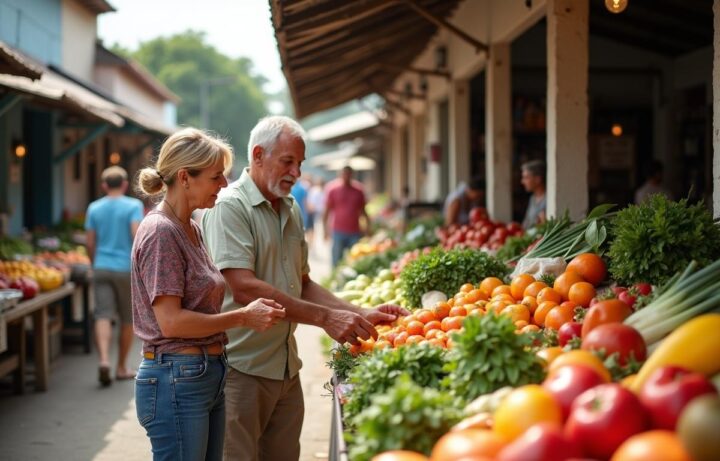Why The Cost of Living in Panama Isn’t What You Think
Panama’s cost of living catches many potential expats off guard. Cost of living in Panama is 33.1% lower than the United States, but reality is different from what people expect. A retired couple needs about $2,600 monthly with rent included – nowhere near the cheap paradise many people imagine.

The numbers tell an interesting story when comparing Panama with other locations. Ocean-view apartments start at $165,000, which is a big deal as it means that Costa Rica’s similar properties cost much more. Panama City shows typical urban pricing patterns, but still gives you good value compared to American cities where you might pay $2,500 monthly for a two-bedroom apartment. Retirees looking at healthcare costs will find great savings here. Doctor visits cost as little as $20, and monthly insurance stays under $200. But there’s a catch – the average after-tax salary in Panama only covers living expenses for 0.7 months, while US salaries stretch to 1.8 months.
This piece gets into the real cost of living in Panama for 2025. We’ll bust some common myths and show you what to actually expect, whether you’re moving alone or as a couple looking for an affordable monthly budget abroad.
The Myths about the Cost of Living in Panama
YouTube videos and blogs often paint Panama as a dirt-cheap paradise where retirees can live like kings on pennies. I’ve explored many Central American countries, and let me tell you – that’s not quite right. Life in Panama has changed a lot in the last decade, creating a different financial picture for expats.
Why Panama is not as Cheap as You Think
Panama ranks among the most expensive countries in Central America, which might surprise you. The cost of living here hits harder than expected, especially in places where expats love to settle. Local produce comes cheap, but imported goods will cost you big time. A bottle of Heinz 57 sauce that’s $3 back home might set you back $10 here.
You’ll save money compared to the USA in many areas, but Panama’s use of the US dollar means no currency advantage. Other countries might stretch your dollars further with good exchange rates. Panama City has grown faster into a modern metropolis with first-world amenities – and prices to match.
Housing brings another reality check. Rural areas offer good deals, but homes in popular expat spots like Boquete start at $200,000. A nice two-bedroom apartment in Panama City costs $900-$1,500 monthly. That’s cheaper than major US cities but nowhere near the $300 deals some blogs talk about.
Setting up a new home comes with its own challenges. Furniture and electronics cost more than in the States because of import taxes and shipping costs. These extra expenses can quickly eat into your predicted savings.
Common Mistakes People Make when Estimating Costs
People often make the mistake of thinking costs stay the same all over Panama. Life in Panama City costs way more than in smaller towns. You might need $2,500 monthly to live well in Panama City, while rural areas might only need half that.
Not visiting before moving stands out as another big mistake. Some expats rent places just from online photos and end up with nasty surprises. One couple paid first and last month’s rent plus deposit, only to find their place looked nothing like the pictures and had serious mold problems.
Utility costs catch many people off guard. Water comes super cheap (usually under $10 monthly compared to Costa Rica‘s higher rates), but running AC in coastal areas can push electricity bills to $300-$400 monthly. My host’s power bill doubled when I stayed in Coronado for a month and used AC regularly.
Your lifestyle choices make a huge difference too. Sticking to American eating habits – especially with imported foods and eating out – will drive up your expenses. Nicaragua might be cheaper for basics, but Panama’s reliable infrastructure comes with its own price tag.
Buying property right away can turn into the most expensive mistake. Take this couple who bought a house without knowing about the area’s water problems. They couldn’t get residency because of legal issues and lost $100,000.
Smart expats usually plan for $1,200-$2,500 per person monthly to live comfortably in Panama. That’s more than what you see advertised, but still saves Americans good money.
What is the Real Cost of Living in Panama in 2025?
Living costs in Panama will vary a lot based on where you live and how you choose to spend in 2025. A comfortable life costs between $770 and $1,580 in rural areas, while Panama City dwellers need $1,570 to $3,000 monthly. Panama’s costs stay about 33% below Costa Rica, which makes it a great choice to retire.
Housing Costs: Rent and Buying Options
Housing takes the biggest chunk of your Panama budget, and prices differ between city and countryside. A one-bedroom apartment in downtown Panama City runs $800-$1,500 monthly, while spots outside the center cost $600-$1,000. Small towns like Las Tablas offer rentals from $400-$700.
Buying property shows the same price patterns as renting. Panama City apartments with ocean views start at $165,000, and luxury homes begin at $200,000. You’ll find much better deals in rural areas, where homes start at $70,000.
The tax benefits of buying property are worth noting. Properties under $120,000 pay no property taxes when registered as Family Patrimony. Properties valued between $120,000-$750,000 only pay a 0.5% tax after 20 years of exemption.
Food and Groceries: Local vs Imported
Food shopping habits play a big role in your Panama budget. Couples spend about $200-$400 monthly on groceries, which beats U.S. prices. Local markets give you the best deals on fresh produce compared to imported items.
Your choice of supermarket matters. Riba Smith stocks imported goods at higher prices, while El Rey and Super 99 keep things budget-friendly. Common items cost around $2.52 for a dozen eggs, $2.40 for a kilo of rice, and $7.30 for chicken filets per kilo.
Nicaragua might be cheaper for some items, but Panama’s reliable infrastructure and better selection make up for slightly higher prices. Eating out costs $4-5 at local fondas, while mid-range restaurants charge $10-20.
Utilities and Internet Expenses Explained
Utility bills make up another key part of Panama City living costs. Monthly electricity runs $60-$200 based on AC use. Panama City’s humidity means higher electric bills, but highland areas like Boquete need almost no AC.
Water bills stay low at $12-$25 monthly, or $100 yearly for unlimited use. Cooking gas costs $5-$10 monthly. High-speed internet runs $35-$60.
Cell phone plans beat U.S. prices at $15-$45 monthly. Cable TV adds $12-$50. An 85m² apartment’s total utility package averages $105, taking about 17% of monthly expenses.
To summarize, Panama offers big savings compared to U.S. costs, except for imported items and high-end housing. Expats who embrace local products and Panama’s lifestyle can live well while spending much less than they would in North America.

Cost of Living in Panama vs USA: Surprising Facts
The cost of living difference between Panama and the USA reveals some surprising truths that go beyond basic statistics. Looking at specific expenses side by side shows a clearer picture for anyone who wants to move south. Let’s dive into these financial realities that most relocation websites don’t tell you about.
Housing and Rent Comparison
Panama’s cost of living really stands out when it comes to housing expenses. US rent prices are 78.5% higher than Panama’s. To name just one example, a one-bedroom apartment in Panama City’s center costs $920 monthly, while you’d pay $1,741 in similar US urban areas. The same goes for three-bedroom apartments – $1,805 in Panama City versus $2,902 in US cities.
Property buyers see even bigger differences. Panama City’s average price per square foot is $200, nowhere near the $301 in US urban centers. This explains why many single Americans find their housing budget goes substantially further, even in upscale areas. Panama’s property taxes are more favorable too, and some properties even qualify for exemptions that don’t exist in the US.
Healthcare and Insurance Differences
Healthcare savings are a big deal in Panama. Doctor visits usually cost under $40, and public hospitals charge as little as $1.50 per visit. Many expats take advantage of this by using private facilities while keeping public options as backup.
Insurance costs are no match for Costa Rica and other regional options. Monthly premiums range from $50-$125 for detailed coverage, while similar US plans cost over $400. Prescription medications cost 30-80% less, and many US prescription-only medications are available over-the-counter in Panama.
Here’s something most people don’t know: Panama has several hospitals affiliated with major US institutions like Johns Hopkins that offer similar quality at much lower costs.
Transportation and Daily Expenses
Transportation costs show another side of Panama City’s advantages over American urban centers. Local transport tickets cost just $0.55 compared to $2.50 in the US, and monthly passes are $25 versus $65.
Gas prices stay similar between both countries, but vehicle ownership costs less because of cheaper insurance and maintenance. Nicaragua might have lower living costs for some items, but Panama’s resilient infrastructure makes it worth the difference.
Daily expenses stretch your dollar further. Restaurant meals cost 68.8% less on average, and grocery prices are 46.9% lower than US equivalents. The trade-off shows in earning potential – the average Panamanian monthly salary covers expenses for only 0.7 months compared to 1.8 months in America.
How the Cost of Living in Panama City Panama Differs from Rural Areas
Panama’s capital and countryside tell two very different stories when it comes to costs. Anyone looking to understand Panama’s cost of living needs to grasp this city-rural divide that affects everything from where you live to what you spend daily.
Living in Panama City: Pros and Cons
Panama City’s cost of living matches its role as a global business center. A comfortable lifestyle here costs between $1,570 and $3,000 monthly. The rent runs high – a one-bedroom apartment downtown ranges from $800-$1,500, and three-bedroom places go up to $1,800. Families with four members should expect to spend around $8,000 each month.
All the same, life in the capital has its perks. The city boasts resilient infrastructure with stable internet, modern healthcare, and great transport options. You can ride the Panama Metro for just 35 cents. This makes getting around affordable even though housing takes a big chunk of your budget.
The city also brings better job prospects, especially in international trade, banking, and tourism. But these benefits come with their share of headaches – heavy traffic, some high-crime areas, and the stress that city life brings.
Rural Panama: Hidden Savings and Trade-offs
Rural areas cost way less than spots in Costa Rica or other retirement destinations. Monthly costs typically run from $770 to $1,580 – about half what you’d pay in Panama City. Housing shows the biggest difference. Rural rents average $350-$750, which is 40% cheaper than city rates.
Grocery shopping in countryside towns costs $200-$350 monthly, and transport expenses average just $20. One person can live well on under $1,000 in many rural spots, though prices change based on location. Power bills also tell a different story – $50 in rural areas compared to $150 in the capital.
The downsides include fewer jobs, limited public transport, and not as many things to do. Small-town residents might struggle to find good healthcare since most specialized medical services stay in the cities. Nicaragua might be cheaper for some things, but Panama’s rural areas have better infrastructure than many nearby countries.
Internet speed – vital for digital nomads – changes a lot depending on where you are, though connections keep getting better across Panama. Your monthly expenses stay pretty steady once you’ve settled into your chosen lifestyle.

Smart Ways to Manage Your Monthly Budget in Panama
Smart money management can make your life abroad much easier. Panama’s living costs might surprise you – they’re quite affordable if you know the local tips that experienced expats use to make their dollars go further.
Tips for A Single Person Living on A Budget
You can live quite well in Panama on $1,000-$1,200 monthly in many areas. Your choice of location will shape your budget – Panama City prices are nowhere near as affordable as smaller towns like Volcan or Las Tablas. Housing takes the biggest bite out of your budget, so you should rent before buying to get a feel for the market. Small-town apartments might cost under $500 with utilities included. Panama City life starts at about $1,570 monthly.
A couple spends $200-$400 monthly on food, but singles can cut this down. Local markets beat supermarket prices – organic greens cost about $2 compared to $4-6 for imported produce. Local brands save you money too – local tomatoes are much cheaper than imported ones.
Your transportation choices matter. Panama City’s public transport costs just $0.50 per ride. This makes owning a car optional if you live in the city.
How to Enjoy Retirement Without Overspending
Panama offers better value than Costa Rica if you plan carefully. The Pensionado program gives great discounts – 25% off utilities and airline tickets, 20% off medical bills, and 50% off entertainment. These savings make Panama even more affordable compared to the USA.
Locally-made furniture costs less than imported household goods. You can save on utilities too – highland areas like Boquete need just $25-50 monthly for electricity, while coastal spots might need $100-300 for air conditioning.
Setting a monthly budget is vital for retirees with fixed incomes. Many expats live well on less than $1,500 monthly. We adapted to local prices and customs to achieve this.
Saving Money on Healthcare and Entertainment
Healthcare savings in Panama City can be huge. Many expats skip health insurance since doctor visits cost only $15-20 without it. Local health insurance runs about $117 monthly with no age limits.
The public healthcare system offers amazing value – some expats paid less than $150 total for several days in the hospital. Medications cost 30-80% less than U.S. prices.
You can enjoy life without spending much. Panama has affordable luxuries like $35/hour massages, $5-10 movie tickets, and $4-5 local meals. Many attractions cost nothing – Casco Viejo, Metropolitan Park, and the Cinta Costera walkway are free.
Your lifestyle choices determine your living costs in Panama. Choose local products, use pensionado discounts, and pick your location wisely to create an affordable and satisfying life here.
Cost of Living in Panama Frequently Asked Question
What is the Average Cost of Living in Panama for a Retired Couple?
A retired couple typically spends around $2,600 monthly, including rent. While this is lower than in the United States, it’s higher than many expect for Central America.
How Do Housing Costs in Panama Compare to the United States?
In Panama City, a comfortable two-bedroom apartment might rent for $900-$1,500 monthly, which is significantly less than similar accommodations in major US cities. However, prices vary greatly depending on the location and amenities.
Are Healthcare Costs Really Lower in Panama?
Yes, healthcare costs are substantially lower. Doctor visits can cost as little as $20, and monthly insurance premiums can be under $200, offering significant savings compared to US healthcare costs.
How does the Cost of Groceries in Panama Compare to the US?
Grocery costs can vary. Local produce is often very affordable, but imported goods can be expensive. A couple might spend $200-$400 monthly on groceries, which can be less than in the US if you primarily buy local products.
Is it Cheaper to Live in Panama City or in Rural Areas?
Rural areas in Panama are generally much cheaper than Panama City. While you might need $1,500-$3,000 monthly for a comfortable lifestyle in Panama City, you could live comfortably in rural areas for $770-$1,580 monthly.
What Are the Typical Utility Costs in Panama?
Utility costs in Panama are relatively low compared to the US. Electricity can range from $50 to $150 per month depending on air conditioning usage, while water, gas, and garbage collection often total under $30 monthly. Internet plans start at around $25 per month for basic service.
Is Public Transportation Affordable in Panama?
Yes, public transportation in Panama is very affordable. A bus or metro ride in Panama City typically costs $0.25 with a Metro Card. Taxis are also inexpensive, with short rides costing $3–$5. Many retirees find they don’t need a personal vehicle in urban areas.
How Much Do Dining Out and Entertainment Cost in Panama?
Dining out in Panama is generally more affordable than in the US. A meal at a mid-range restaurant for two costs around $30–$40. Entertainment options like movies ($4–$6 per ticket) or local tours are also budget-friendly, making leisure activities accessible.
Are Imported Goods Expensive in Panama?
Yes, imported goods such as certain food brands, electronics, and clothing can be significantly more expensive due to import taxes. Shopping local and buying Panamanian products can help reduce your monthly expenses.
What Are the Costs of Visa and Residency for Expats in Panama?
Visa and residency costs vary depending on the type, but the Pensionado Visa—a popular option for retirees—can cost $1,500 to $3,000 in legal and processing fees. This visa offers discounts on travel, healthcare, and more, making it a cost-effective long-term solution.


